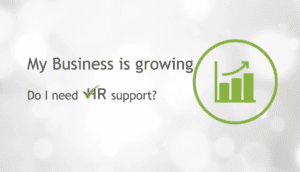My Business is growing. Do I need HR support?
The Importance of HR Support for Growing Businesses: Maximising Success and Minimising Costs”
In today’s ever-evolving business landscape, the need for HR support is crucial, especially as your business begins to grow. While smaller businesses might view HR as a luxury or an afterthought, the reality is that it can make or break your success. Here’s why you may need to consider HR support as an essential part of your growth strategy.
Complexity in People Management
As your business expands, managing your workforce becomes more complex. You may need to attract talent with specific skills to drive your product or service development and increase market share. In return, these employees will expect clear career progression paths, competitive benefit packages, and opportunities for skill development. Without these offerings, high turnover rates can become a costly issue.
Navigating Challenges
As your workforce grows, so do the challenges. Issues such as misconduct, poor performance, and grievances may arise. While in the past, these problems may have been resolved informally, it’s essential to follow proper processes outlined by the ACAS code of conduct. Failure to do so can lead to expensive claims for unfair dismissal.
HR professionals can guide you through these processes, mitigating potential risks and reducing the cost of legal claims.
Measuring the ROI of HR
To understand the impact of HR on your business, consider measuring your employee retention and turnover rates. A high retention rate indicates engaged employees actively contributing to your business’s success. Conversely, a high turnover rate suggests underlying issues. Benchmarking these rates against industry standards helps identify areas for improvement and cost reduction, including the expense of missed opportunities.
Anonymous staff surveys and exit interviews provide valuable insights into potential problems before employees decide to leave, allowing proactive solutions.
Stability Matters
Effective HR practices also influence employee stability, particularly for new hires. New employees join your organisation with high expectations, and it’s crucial to ensure they have the necessary skills and resources for their roles.
A stability index, aligned with industry norms, helps assess your organisation’s effectiveness in meeting these needs. Maintaining a stable workforce (generally an average rate of 90% or higher) ensuring you benefit from fresh ideas, innovation, and growth while keeping recruitment and onboarding costs in check.
The Finance-HR Partnership
In smaller organisations, the partnership between finance and HR is critical for efficient operations. Finance relies on HR to provide accurate data on new hires, departures, leavers, and salary adjustments as your teams expand. HR must demonstrate the value of new initiatives, such as hiring plans and training programs, to ensure alignment with the organisation’s operational and financial goals.
In conclusion
As your business grows, HR support becomes increasingly vital. It’s not just a “nice-to-have” luxury but a strategic necessity for attracting, retaining, and effectively managing your workforce. By investing in HR, you can maximise your business’s success while minimising costs and risks associated with poor people management practices.

